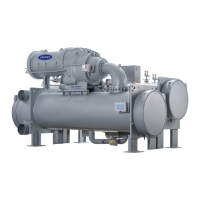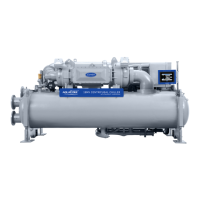79
3. Calculate an average Amp Meter Current of the three in-
put phases.
4. Calculate the line side error ratio using the following
equation:
* in POWER screen.
5. Shut down the chiller.
6. If the Line Side Error Ratio is greater than ± 0.02 adjust
the ICVC reading by adjusting the MOTOR CUR-
RENT CT RATIO in the ISM_CONF screen. This
screen can only be accessed when the chiller is not run-
ning.
Change CT Ratio
1. New MOTOR CURRENT CT RATIO = Present MO-
TOR CURRENT CT RATIO multiplied by (1+ Line Side
Error Ratio).
To access the ISM_CONF screen:
2. Press .
3. Press .
4. Enter the password 1111.
5. Select ISM (STARTER) CONFIG DATA.
6. Enter password 4444.
7. Select ISM_CONF.
8. Change present MOTOR CURRENT CT RATIO to new
ratio using calculation above.
9. Press to the softkey to save changes.
10. Press the softkey to exit the ISM_CONF screen.
11. Repeat ISM Current Calibration Check.
VFD Current Control Calibration Check
1. With the TARGET VFD SPEED at 100%, load the
chiller so that the ICVC default display shows 75% to
100% under the ICVC default screen display title AMPS
%. A higher load is preferred.
2. Access the current on the keypad of the VFD. Determine
the Load Side Current Ratio, using the equation below.
Next, access the VFD LOAD FACTOR on the Capacity
Control screen. Calculate the Load Side Error Ratio using
the equation below:
3. If the load side error ratio is greater than ± 0.02, adjust the
VFD LOAD FACTOR by changing the VFD CUR-
RENT LIMIT on the Setup 2 screen.
a. The new VFD CURRENT LIMIT = old VFD
CURRENT LIMIT multiplied by (1+ Load Side
Error Ratio).
b. Recheck the VFD Current Control Calibration.
c. Release the Speed Control by accessing the TAR-
GET VFD SPEED control.
Press .
Press .
Press .
(Refer to Override Operations section on page 23.)
HAND CALCULATE SURGE PREVENTION CONFIG-
URATIONS — The configurations entered determine the
Surge Prevention line that the controls use to raise the speed of
the VFD if the compressor operating point nears this line.
Calculate ΔP maximum and ΔP minimum using 2 point
method in the preceding section. If the original selection con-
figuration points are available, use ΔP1 and ΔP4 from that se-
lection as ΔP maximum and ΔP minimum. If the original selec-
tion configuration was for a 2 point surge line, use ΔP1 and
ΔP2.
Use the default values for the following configurations:
• Surge / HGBP IGV min. = 5.0
• Surge / HGBP IGV max = 100.0
• Surge Line Shape Factor = -0.040
• Surge Line Speed Factor = 1.85
• Surge Line High Offset = 1.0
• Surge/ HGBP Deadband = 1
Calculate Surge/ HGBP Delta Tsmin
— Convert design suc-
tion temp to pressure using an R-134a pressure/temperature
chart.
Min. Cond. Pressure = (suction pressure) + (ΔP minimum)
Convert Min. Cond. Pressure to Min. Cond. Temperature
using a saturation pressure/temperature chart for R-134a.
Surge / HGBP Tsmin = (Min. Cond. Temp.) – (design suc-
tion temperature)
Calculate Surge/ HGBP Delta Tsmax
Max. Cond. Pressure = (suction pressure) + (ΔP maximum)
Convert Max. Cond. Pressure to Max. Cond. Temperature
using a saturation pressure/temperature chart for R-134a.
Surge / HGBP Tsmax = (Max. Cond. Temp) – (design suc-
tion temperature)
VPF Surge Prevention Configurations are defined as fol-
lows:
• Surge/HGBP Delta Tsmin is the minimum difference
between cooler and condenser saturation temperatures.
(See Fig. 37.)
• Surge/HGBP IGVmin is the lowest position of the guide
vanes that affects Surge prevention. This is not likely to
require adjustment at the jobsite other than to ensure that
it matches the value supplied with the machine selection.
These values produce the minimum load point of the Surge
Prevention line:
• Surge/HGBP Delta Tsmax is the maximum difference
between cooler and condenser saturation temperatures.
(See Fig. 38.)
• Surge/HGBP IGVmax is the highest position of the
guide vanes that affects Surge prevention. This is not
likely to require adjustment at the jobsite other than to
ensure that it matches the value supplied with the
machine selection.
NOTE: The preceding two values produce the full load point
of the surge prevention line.
• Surge Line Shape Factor determines the curvature of the
line mainly in the low load zone. (See Fig. 39.)
• Surge Line Speed Factor determines how much the surge
line moves to accommodate lower compressor speed. As
compressor speed drops the ΔT values on the surge pre-
vention line decrease. Increasing the Speed Factor causes
Surge Prevention to activate sooner as the compressor
speed drops. (See Fig. 40.)
• Surge Line High Offset determines the ΔT increase
beyond the surge prevention line where the high stage of
Surge Prevention takes effect. The high stage produces
larger RPM increase steps. This is not likely to require
adjustment at the jobsite other than to ensure that it
matches the value supplied with the machine selection
Error Ratio =
Amp Meter current –
ACTUAL LINE CURRENT*
Amp Meter current
Load Side
Current Ratio
=
VFD Actual Load Amps (from VFD)
VFD CURRENT LIMIT (in SETUP2)
Load Side
Error Ratio
=
VFD LOAD FACTOR – Load Side Current Ratio
Load Side Current Ratio

